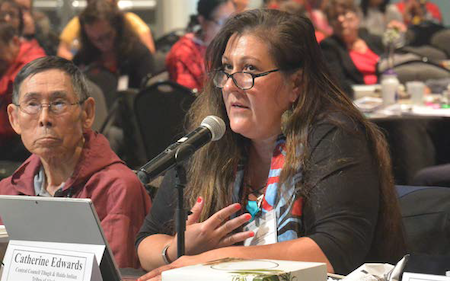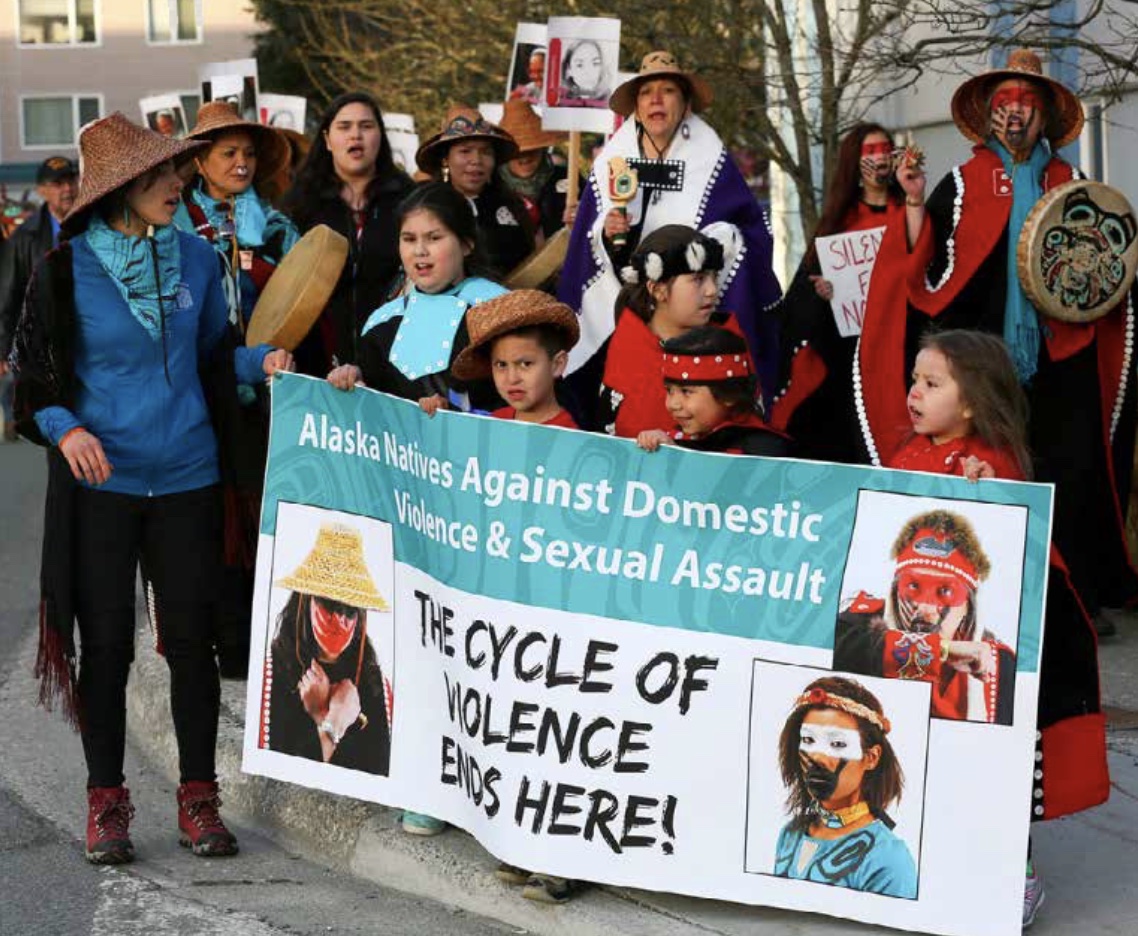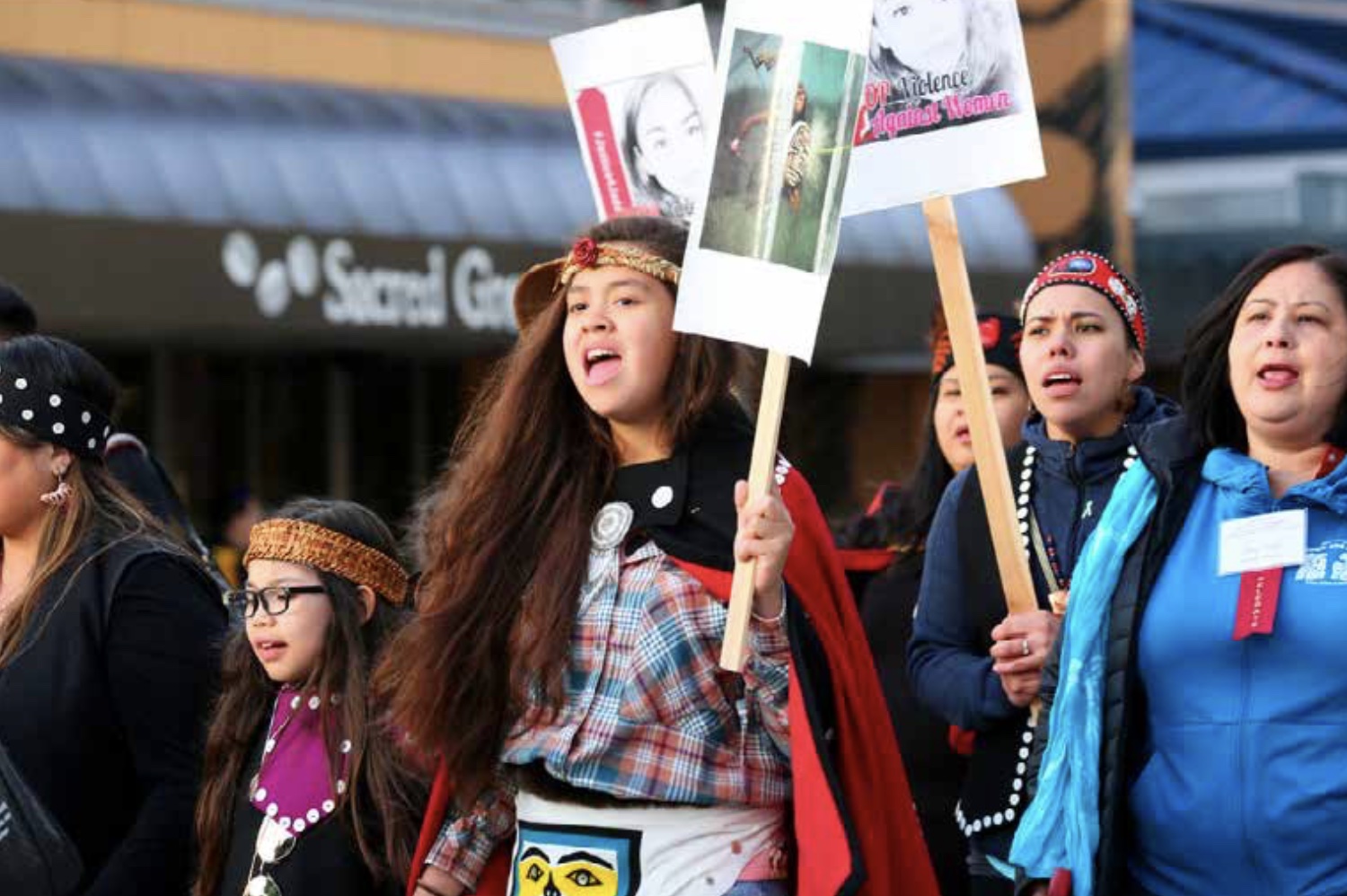Not Invisible Act Consultation, September 10, 2021

Catherine Edwards, Central Council Tlingit and Haida Indian Tribes of Alaska. (NIWRC)
Statement of Catherine Edwards, Central Council Tlingit and Haida Indian Tribes of Alaska
I am Catherine Edwards, the first Vice-President of the Central Council Tlingit and Haida Indian Tribes of Alaska. We represent 22 villages in Southeast Alaska and 3 urban populations in Anchorage, Alaska, California, and Washington, with more than 32,000 citizens. Thank you for the opportunity to provide comments on the Not Invisible Act––Gunalcheesh! I would like to say that I am honored to be here and honored to be a representative of my people. Though after many years of being involved with this work and testifying in various federal consultations each year, I continue to hope that someday we could stop repeating the same messages and requests.
I will respond to your questions, but before I do, I want to make a strong case to have significant representation from Alaska stakeholders. Far too often our situation is overlooked and misunderstood given the challenges that our communities face with the lack of law enforcement in many of our communities, the remote locations, extreme weather exacerbated by global warming and the extractive industries effects on our communities.
Our communities, both rural and urban, continue to lack basic services that would help to increase the safety for our women, children, and families. My goal in testifying again and again to federal agencies is to give voice to the voiceless and remind you that violence against women in our communities is in crisis. Each and every day, as these meetings are taking place, violence is happening to our families and our communities are suffering. It is my hope that you will listen, not just to our stories, but also think about what resources should be provided to us and then visit us, listen to us. We know what to do. We simply need help with resources and partnerships.
I am also the co-chair of the Tlingit and Haida Violence Against Women Task Force that was established in 2017. The Task Force is a community-driven response to end domestic violence and to address cases of missing Alaska Native women. It is charged with studying, analyzing, reporting, and providing recommendations on how to:
- Improve criminal justice system to better serve and protect Alaska Native women;
- Increase criminal justice protective and investigative resources for reporting and identifying murdered and missing Alaska Native women;
- Identify rates of violence against women and reduce incidences through continuing efforts to connect state, tribal and federal resources;
- Address issues relating to public safety and law enforcement that create barriers for responding timely to violent crimes against Indigenous women in rural Alaska communities;
- Identify effective tribal justice methods used to reduce violence against Alaska Native women; and
- Create partnerships with local, state, and national organizations for resource development (such as the Alaska Native Women's Resource Center, National Indigenous Women's Resource Center and NCAI’s VAW Task Force.
Why do we need such a group? Because the Federal government has and continues to fail the trust responsibility to our Tribal communities, especially in providing necessary resources to decrease violence and increase safety from domestic violence and sexual assault.

In the 1960’s my Grandmother’s sister, Auntie Butch was beaten, raped and, left in a ditch where my Uncle, 15 at the time, had to claim the body, and the local police wouldn’t do anything about it or help him, because she was Alaska Native. Two years ago, my daughter fled our homelands because of a stalker. When she attempted to seek help through the State court, the Judge not only allowed her stalker to question her, and denied her request for a protective order, saying she was simply too nice. All of this in spite of the fact that the perpetrator was in court just two months prior, also for stalking another woman––he is now running for School Board!
Alaska continues to rank in the top five in the rate of women murdered by men and we know this rate is higher for American Indian/Alaska Native women. We know that women killed by men are most often killed by someone they know, and more than half are killed by an intimate partner. Here we are in 2021 and we still have Native women beaten, raped, and left in ditches and law enforcement isn’t helping. In 50, 60 years we really haven’t come very far. We as Alaska Native women represent 50% of sexual violence and while American Indians are overrepresented in DV/SA, Alaska Natives are among the most victimized nationwide being victimized 2x the national average and in some areas even higher. They say 1 in 3 American Indian or Alaska Native women have experienced sexual assault and domestic violence. However, I have yet to sit in a group of my Tribal sisters and find the 2 out of 3 that have not been sexually assaulted or beaten. We really haven’t come very far.
We continue to remind the federal agencies, year after year, that in Alaska we do not have adequate law enforcement and lack the resources to remedy this situation on our own. In addition, we currently have a Governor who continues to cut law enforcement funds and support for the Tribes. Tlingit and Haida Tribe has run the Village Public Safety Officer program in Southeast Alaska, however, only has the funding to provide VPSO in a small number of our 22 communities. Due to the budget cuts and retention difficulties, a VPS officer is the only law enforcement presence, often on call 24/7 and not well paid. These officers also do not have arrest authority and are not allowed to carry firearms. This explains the low retention rates and recruitment difficulties.
The last fifteen months, with the COVID-19 Pandemic, we have seen conditions and safety in our villages drastically worsen. Lack of adequate housing, an issue before COVID, has forced victims and children to remain in the homes of their abusers. Many of the rural villages throughout Alaska thus do not have shelters or safe houses that can provide refuge and safety. The lack of sufficient funding for preventive services and resources prevents our communities from teaching how to live in safety and unlearn violence. Safety, wellness and eliminating violence for our tribal communities and citizens continues to be our top priority.
Also, do not forget about the Department of Justice State of Emergency in Rural Alaska Declaration. On June 28, 2019, DOJ stated an emergency in rural Alaska existed and provided some resources—primarily to the state to back-fill the state cuts. We need on-going support and assistance to build the necessary infrastructure to address the dire jurisdictional issues that are truly health, safety and welfare issues and such assistance is required by the federal trust responsibility.
Again, Alaska is often overlooked or misunderstood about the extreme conditions that many of our communities face and we need strong VOICES, not VOICE, but VOICES at the table.
We believe the NIA Commission should review and adopt these recommendations:
- Implement NCAI recommendations regarding the tribal set-aside from the crime victim fund to assure that the resources reach victims, survivors, and their families;
- Fully implement the 2005 reauthorization of the VAWA NIJ research program and specifically provide Tribal Nations information regarding missing and murdered AI/AN women;
- DOJ and DOI should review, revise, and create law enforcement and justice protocols appropriate to the disappearance of AI/AN women and girls, including interjurisdictional issues as provided by the Savanna’s Act and Not Invisible Act;
- Support efforts of the Government Accountability Office to prepare and submit a report on the response of law enforcement agencies to reports of missing or murdered Indians, including recommendations for legislative solutions as provided by the Studying the Missing and Murdered Indian Crisis Act of 2019;
- Develop protocols, in consultation with Tribal Nations, which recognize the inherent right of American Indians and Alaska Natives to exercise their traditional practices in response to MMIW. These protocols must address the current violations of tribal beliefs, religious, and cultural practices of the murdered woman and the disrespectful handling of her remains. The protocols must address the following:
- The denial of request by mothers and other immediate family members to see the bodies of their loved ones. In many cases, the requests of family members to see the remains of the AI/AN woman have been denied without explanation.
- Develop law enforcement toolkits that provide for a thorough investigation and answer the necessary questions so coroners can correctly identify the “manner of death.”
- Mailing and shipping remains without notice to the family and sometimes without proper clothing and modesty covers. In many cases, mothers and families have received the naked remains of their loved ones in cardboard boxes and plastic bags.
- In adjudicated cases, return of the victim’s personal effects and belongings to the family, if desired, for proper disposal and/or burial consistent with cultural practices.
- Coordinate efforts across all federal departments to increase support for tribal responses to missing or murdered AI/AN women and girls as required by Savanna’s Act;
- Coordinate efforts in consultation with Tribal Nations to increase the response of state governments, where appropriate, to cases of the disappearance or murder of AI/AN women and girls; and
- We recommend the federal departments under the VAWA mandated consultation support this investigation and allow Indian Tribes to use VAWA grant funds to participate in relevant meetings at the United Nations and with United Nations’ bodies.

Now to answer your questions:
- What, from these topics, is a priority that would most benefit your Tribe and/or community? We need a comprehensive plan that includes mapping out the origin of the violence, the various intersections of domestic violence, stalking and trafficking and map out what works and hasn’t worked—what resources have been provided and what ones are needed now to make a difference? For example, we know that our children are disproportionately represented in child welfare because often, the state does not understand our communities and removes our children from our communities. These children are disproportionately targeted by traffickers. Eventually they come into the judicial system and are viewed as criminals rather than as the ongoing victims of racist institutions. This is just one example of the mapping that is needed.
- Are there other topics related to the Commission's objectives that you wish the Commission to consider? Yes, we need to look at the grant solicitations that leave out our Alaska communities. For example there is a grant called, FY 2019 Law Enforcement-Based Victim Specialist Program. With the increased VOCA funding for Tribes, the Alaska Native Women’s Resource Center proposed working with Tribes to get a victim-based specialist with all Village Public Safety Officers (VPSO’s). We thought this would be a great start to providing more services. Sadly, our VPSO’s did not meet the definition of “law enforcement” so we could not pursue this track. These VPSO’s are the closest thing we have to law enforcement and to exclude our communities based on this poorly drafted definition shows how so often we are shut out of available programs.
- Every Agency that provides grants and programs to Tribes should have a meaningful tribal group to administer the program. OVW is the only program that has a statutorily mandated tribal group in DOJ or HHS programs, but administratively this could be accomplished. FVPSA does a great job with so little funding—their example should be replicated. Director Shawndell Dawson and Deputy Commissioner Powell just held a two-day consultation and by day two they announced changes and promised quick responses to other questions.
- Implementation of the Act requires that the Commission include representation from and coordination across several federal agencies. Are there agencies, bureaus, offices, or programs you believe should be represented on the Commission that are not listed in the Act? Yes. The CDC should be part of the federal programs. Again, there are so many intersections of issues and services needed. In Alaska, we need to have the state Attorney general involved in policy change—I am sure other PL 280 states may have similar issues with roadblocks by their AG’s as well.
Gunalchéesh––Háwʼaa––Thank you for taking the time to listen to our concerns; and we will be submitting written comments.





